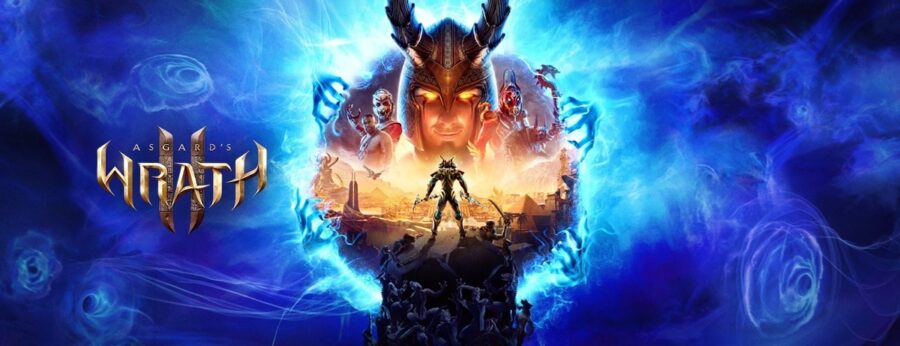
TL;DR for Asgard’s Wrath 2
(played on a Meta Quest 3 128 GB model)
| Pros | Cons |
| + Great core gameplay | – Filler side content |
| + Feature packed | – Shallow loot system |
| + Cool cinematics |
By now you probably already know that Asgard’s Wrath 2 is very good. The hype train is chugging full steam ahead for the Meta Quest 3’s inaugural open-world Action RPG. IGN even gave it a perfect 10!
So you know the game is good. And if that’s all you wanted to know, and the idea of an open-world VR ARPG (action role-playing game) gets your blood pumping and you’ve got USD $60 burning a hole in your pocket, then just get it. It’s fun. No need to read further.
If, however, you’re a bit more conservative with your time or money and you want to be certain that Asgard’s Wrath 2 is worth the investment, then let’s have a closer look at Sanzaru Games‘ new hit.
STORY
Three parts Legend of Zelda, two parts God of War, a healthy pour of Journey of the Gods, and a dash of Prince of Persia, reverse dry shaken and served neat in a coupe glass. Asgard’s Wrath 2 is a direct sequel.
But if—like me—you haven’t played the first one, that’s okay. There’s an optional recap at the very beginning of the game that goes basically like this:
- You are a fledgling god. Loki—your mentor and trickster god—betrayed you, trapping you in a celestial tavern of his making and escaping to another realm.
- The game begins with you being rescued by the Fates and taken to the “In-Between”—the branching, ethereal World Tree syncretically connecting different planes (and mythologies)—from which you then descend into Egypt to pursue Loki.
The story, so far, is fine.
It is a simple but grand epic adorning the semi-linear gameplay. I say the story is fine “so far” because I have not yet completed this game. It is massive. In fact, Asgard’s Wrath 2 is so feature-packed that it has its own almost entirely separate roguelike mode—“Uncharted Rifts”—accessible through the In-Between.
Uncharted Rifts, by the way, is tight as hell.
It lets you try out different skill tree builds every run, and includes time trials and areas with excellent platforming as well. If it had more puzzles I would call it the synthesis of all of the best parts of the main game.
And man, if they told me from the beginning that the only way to unlock new Rifts was by advancing in Asgard’s Wrath 2’s story, you bet your ass I’d be twice as far in by now! But as it stands I’m probably less than a quarter of the way through the story. And from this vantage point, that story is nothing groundbreaking.
Fifteen years ago it might have been sheerly novel enough to be compelling, but in 2024? We’ve all seen enough costumed, multiverse-roaming ascendants reacting to Loki’s machinations in this timeline thank you.
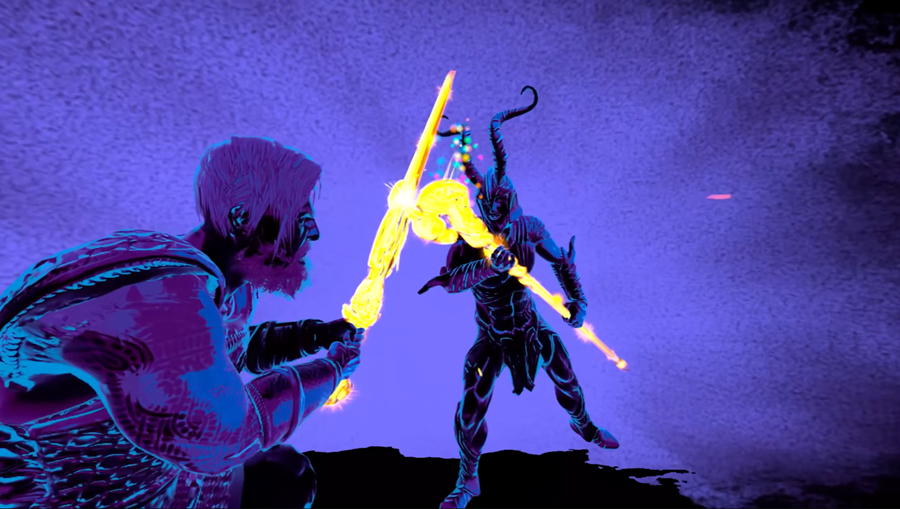
And certainly if we consider the adage “story is character” then we are left sorely wanting. Nearly every character I’ve met—including Abraxas, our protagonist thus far—is pretty stale, landing somewhere on the Venn diagram of “monotonous stoic” and “bit-of-a-prick.”
You never know, though! Maybe there comes a point where some of these seemingly flat characters encounter problems beyond Macguffins and daddy issues to get to interesting arcs that dovetail into a rich story. Could be true. I’m not that far yet.
But for now, the story to me seems just mythical motifs and imagery with thinly conceived plot and characters. And as damning as that might initially sound, the thing is—compared to most VR games—that’s actually tons.
Pistol Whip and Beat Saber, for example, are just on-rails music videos respectively starring John Wick and Danny Trejo’s Machete. Superhot has a cool little bit of story woven in metatextually but is largely ignorable. And War Thunder I’m pretty sure is a psyop for the military-industrial complex.
Loads of the biggest VR titles are just some fun core mechanics, with subtle variations, in perpetuity. And next to those? Asgard’s Wrath 2 may as well be The Odyssey.
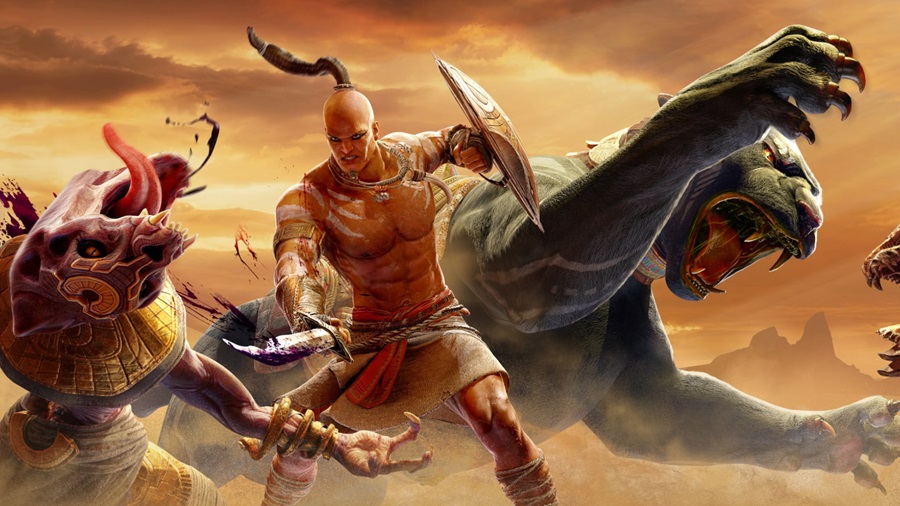
GAMEPLAY
And when it comes to core mechanics Asgard’s Wrath 2 excels. Combat is a high point. The difficulty can be changed at any time from the start menu, but the skill floor is low enough for pretty well anyone to play, and the skill ceiling is high enough to always present some challenge.
That said, melee combat in VR comes with inherent difficulties. The experience of weight, depth, and collision can be hard to simulate, but the game brings you into the fight with visceral feedback.
Executing enemies feel badass!
Your final strikes dismember enemies more often than not. You can cut off their heads or their arms or split them straight down the middle! Throw your axe—decapitate an enemy, call your axe back to you—and it might just return with a head attached!
Neato!
At first the combat can seem sort of clunky and random, but it rewards a studious pupil. Once you understand certain nuances—that parrying costs stamina, that standing too close to an enemy causes you to hit with the hilt of your weapon, that you can recall your weapons faster by just reaching back to their sheathe—combat starts to feel more purposeful and beautiful than accidental and chaotic.
The combat is broken up with sections of satisfying platforming and thought-provoking puzzles…
But even once you start to get the hang of combat, certain aspects remain a problem in the heat of battle. You may accidentally bang your weapons together, confusing it with an enemy attack and pulling your attention from the actual threat in front of you.
You sometimes gain “Divine Protection” for killing enemies—an armor stat that has to be brought down before an enemy can directly target your health—and the visual cue for gaining it is almost the same as the visual cue for losing it, meaning you might think you got hit when you didn’t or vice versa.
Moreover, your “belt”—the quick access menu for whatever handful of items you decide on—is mapped to a press of the left thumbstick, which despite my best efforts I ended up accidentally clicking during several fights.
This led to immersion-breaking moments of Abraxas telling me “I don’t need that right now” in response to a mistaken selection of a healing potion, or worse, the accidental use of a rare potion in an inopportune moment.
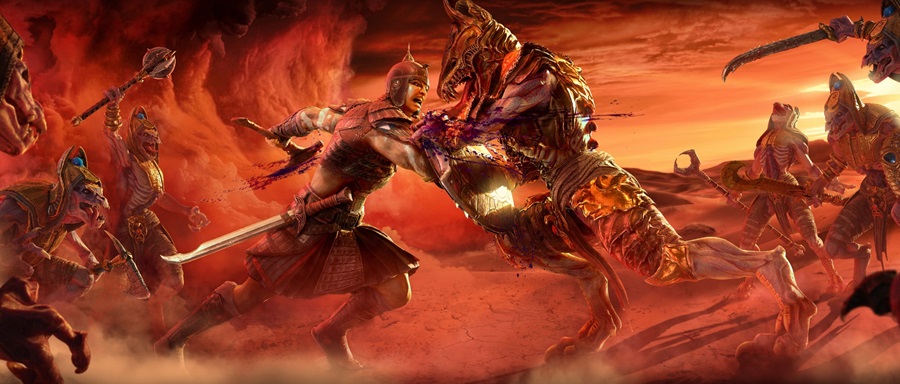
The combat is broken up with sections of satisfying platforming and thought-provoking puzzles, including sections that require you to switch back and forth between your mortal form and your god form.
One moment you’re a warrior, looking up at colossal statues with vultures flying high above. Then light fills your vision from all sides as you switch to your god’s eye view. You reach only an arm’s length up into the heavens and pluck down a vulture, harnessing its vital energy to move one of the statues, and a switch is revealed for your mortal to strike with his axe.
It feels epic.
By keeping this kind of variety, the main campaign stays fresh and satisfying, but—as I see it so far—the game suffers once you stray too far off the beaten path. This, to me, comes down to two related factors:
- The repetitive content padding of side areas;
- The overly randomized loot system.
The completionist in me wants to go back to every unconquered cave and enemy encampment I spot; to open every hidden treasure chest that shows up on my map.
And the game, presumably, wants me to do that too!
But those caves and encampments are just the same simple one or two-room encounters again and again! And there’s no promise of satisfying loot for doing them, either. The loot system too frequently had me finding better drops in the ubiquitous smashable pots and boxes strewn about the world than in the treasure chests I fought hard to plunder.
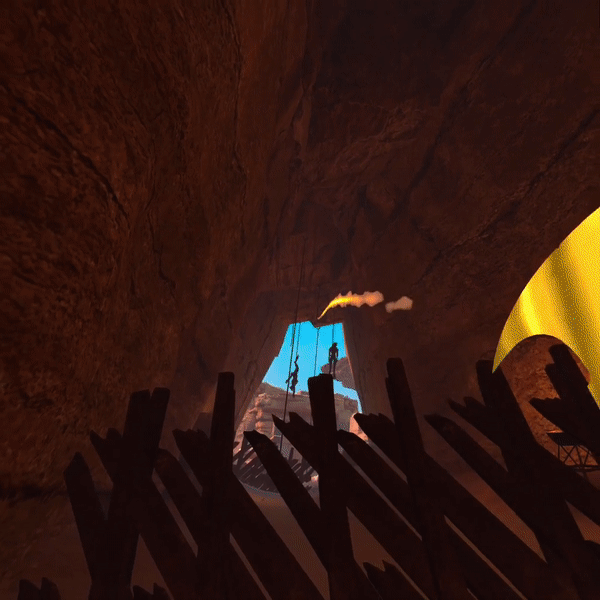
It feels bad to summon your resolve, go back again and again to a tough fight with over-leveled enemies, finally clear the cave of baddies, solve a puzzle, and platform up two stories to the treasure chest only to be rewarded with literal pocket lint.
That completionist impulse could only be betrayed so many times before I decided I was better off simply leaving it alone, even if it meant abandoning that lovely tick-all-the-boxes dopamine hit.
So this very fundamental selling point—this thing that has been central to the overwhelming praise of the game—its size, is to me a bit cheaply inflated, and I really wish it weren’t. I mean there’s so much packed in here already, even just in the main quest! Why the fluff?
Where other open-world adventures like Skyrim or Breath of the Wild find more or less satisfying ways to reward non-linear exploration—new weapons, rare loot, magical power-ups, fun mini-games, or world-building artifacts—Asgard’s Wrath 2 falls short.
While I have a professional responsibility to air my grievances, I also have a professional responsibility to let you know: I love this game.
Open-world games do well when you can look off into the distance, see something awesome, go to check it out, and get distracted over and over by something fun along the way. But I get the impression that the developers just wanted to call the game “open world”, and to that end copy-pasted assets around a too-large map, making vast swaths of filler along the game’s periphery.
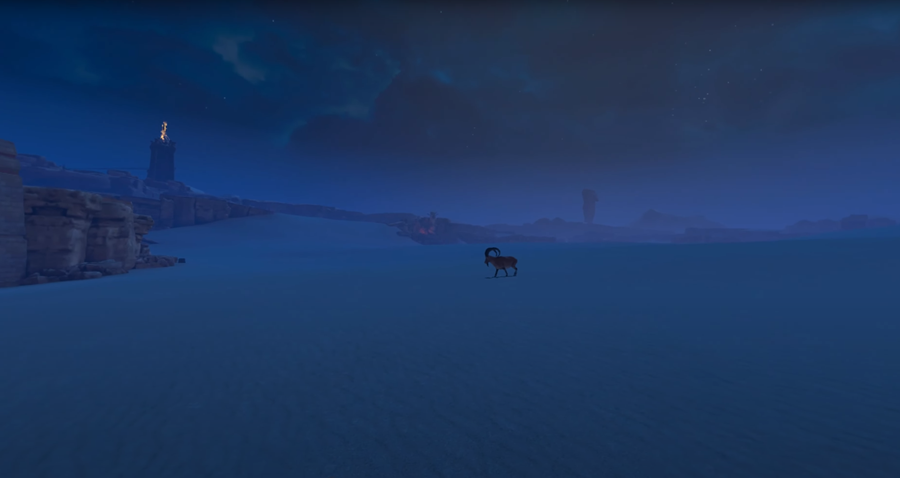
They perfectly seared a gourmet Italian sausage, then they popped it in some Wonder Bread.
While I’m already being critical, let me rattle off a few more gripes:
Performance issues. My copy at least is somewhere in the realm of an on-release Bethesda title; noticeable but manageable, with nothing game-breaking so far. There are sometimes crashes and, more often, noticeable framerate drops.
Lackluster animations for fast-climbing and opening doors—while small—were frequent enough to chip away at my sense of immersion.
The game’s audio is overly compressed to the degree that certain points of dialogue sound as if they’re spoken through a walkie-talkie. And certain textures are just plain ugly up close.
If those crass renderings were an unfortunate sacrifice at the altar of trimming down this game’s already significant 25 GB size, I would make the case that they could’ve just dressed the sausage better and thrown away the Wonder Bread.
Now bear in mind; some of my incisive gripes may be resolved further in the game, or in future patches. Bug fixes have already come through in the game’s first patch, as well as a resolution upgrade for players using the Quest 3. The free unlockable seasonal content and online events are evidence too that this game will get some love from the developers for quite a while yet.
While I have a professional responsibility to air my grievances, I also have a professional responsibility to let you know: I love this game. Look to Proverbs 13:24. I hit Asgard’s Wrath 2 because I want what’s best for it.
There’s just so much good stuff here, including so much yet unmentioned—the followers, mounts, mini-games, crafting, immersive cinematics, and more—that there can be little doubt; Asgard’s Wrath 2 is great. But whether or not it can be called a “masterpiece” is a question of perspective (although the fact that it even comes up is an indicator of quality in itself).
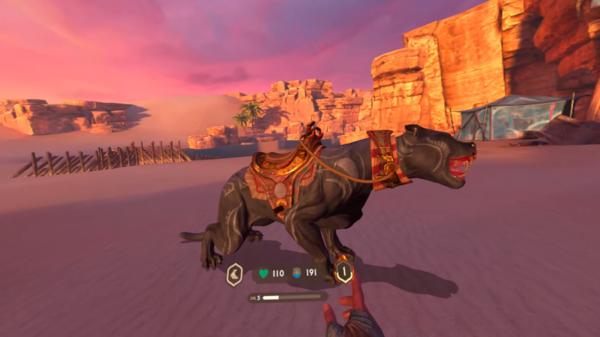
And by perspective, I don’t just mean the subjective tastes of a player, that subjectivity applies to all audiences of all art and—while necessary to remember—is plain enough to be hardly worth mentioning. Rather, whether we judge this game as a masterpiece is a question of perspective in terms of what we consider to be its competition. The size of the fish is relative to the pond.
Is our perspective triangulated within some arbitrary number (#) of more-or-less specific categories like the (1) current landscape of (2) standalone (3) VR (4) ARPGs?
Is our perspective based on the current landscape of all videogames?
Is it based on how much we perceive the game to have achieved some ineffable videogame ideal perhaps never to be fully manifested but still sensible, in its absence, by our higher faculties?
Is it based on how the game ranks comparable to literally any other thing we could do in our lives given a similar amount of time and money?
Some rare games just are masterpieces, and it doesn’t matter how we frame our perspective.
Take The Legend of Zelda: Ocarina of Time. There will perhaps never be another game so profoundly revolutionary to its time: The switch from 2D to 3D. The introduction of target locking and context-sensitive inputs. The level design. The puzzles. The merging of so many previously disparate gameplay elements into something cohesive and polished and fun and immersive on a new system in a new dimension.
This is what a “perfect” game looks like. Not one literally without flaws, but one that revolutionizes the industry somehow; one that captures something never before captured, that future games will copy, alter, and integrate.
So does Asgard’s Wrath 2 do that?
Maybe incrementally. Not for gaming as a whole, mind you, but this is a big fish.
VERDICT
If we let our sights get narrow enough, then Asgard’s Wrath 2 gets its crown. It is far and away the most impressive and feature-rich standalone VR ARPG. And it is a massive step forward for standalone VR in general. Nothing else touches it right now in terms of scope. But bigger is not always better. The more things you put in a game, the more things your game can fall short on.
Luckily, Asgard’s Wrath 2 is at least passable on all counts and exceptional where it matters most: its core gameplay. So, for sixty bucks (or for free with the Meta Quest 3 at the time of writing this)—and without a PC tether—you too can go experience a real-deal world-spanning adventure in VR.
Based on these first impressions, Asgard’s Wrath 2 gets an 8/10.
Scoring & Rubric
Scores are out of 10, where 10 is a masterpiece, 1 is unplayable, and 5 is just average. Gameplay has a heavier weighting toward the overall score.
Gameplay – 9
Immersion – 8
Visuals – 8
Sound – 6
Performance – 6
Replayability – 8
Image credit: Sanzaru Games
About the author
Kierkegaard once said that the artist is like one stuck inside Phalaris' brass bull, which burned up its victims and—due to the formation of its apertures—made beautiful music from their anguish.
The critic, he said, is just like the artist except he doesn't have the anguish in his heart nor the music on his lips.
A lifelong gamer based out of Vancouver, Pelé disagrees with Kierkegaard.
